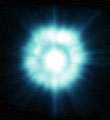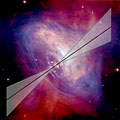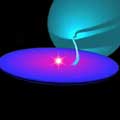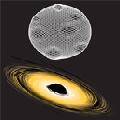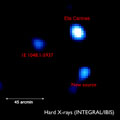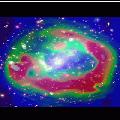INTEGRAL News Archive for 2008 - INTEGRAL
INTEGRAL News archive for 2008
ISOC Newsletter #21
16 December 2008 In this issue of the ISOC Newsletter:
- Foreword
- AO-6 and AO-7
- Science Operations
- The 7th INTEGRAL Workshop
- Changes at ISOC
- Contacting ISOC
Read more in the ISOC Newsletter #21

Extension of AO-6
19 November 2008 In consultation with the INTEGRAL Users Group, it has been decided to extend the duration of the ongoing AO-6 cycle of observations by two months, therefore AO-6 will be ending now on 16 October 2009. There are sufficient accepted observations available to cover the extension interval.
Also, the duration of the following cycle (AO-7) will be extended by 2.5 months, and AO-7 will therefore last from October 2009 until end of December 2010. The subsequent AO's are expected to be annual again.
The reasons for this change are, in brief:
- Since the early mission there is an accumulated carry-over of about 2 Msec per AO cycle, which despite improvements to the planning efficiency could never be fully suppressed. This carry over can be cleaned up and thus no longer affect future AOs.
- In the current scheme, the AO observation cycle is not synchronized with the cycle of mission extensions, as the mission is currently approved until 31 December 2012.
- Finally, a later start of AO-7 observations allows for a less busy schedule for TAC and ISOC in implementing the new scheme including all observing time and data rights proposals.

XMM-Newton and INTEGRAL clues on magnetic powerhouses
14 November 2008 X-ray and gamma-ray data from ESA's XMM-Newton and INTEGRAL orbiting observatories has been used to test, for the first time, the physical processes that make magnetars, an atypical class of neutron stars, shine in X-rays.

Happy Birthday INTEGRAL!
17 October 2008 INTEGRAL is celebrating six successful years in space today! Instruments and spacecraft are continuing to perform well and the scientific output keep the community busy as the recent workshops in Copenhagen and Roma demonstrate. We are all looking forward to more years of discoveries and interesting results.

Faint gamma-ray bursts do actually exist
13 October 2008 Gamma-ray bursts, powerful glares of high-energy that wash through the Universe once every day or so are, for a brief time, the brightest objects in the gamma-ray sky. ESA's INTEGRAL gamma-ray observatory has observed several low-luminosity gamma-ray bursts, confirming the existence of an entire population of weaker bursts hardly noticed so far.

Public TOO on H 1743-322
10-24 October 2008 INTEGRAL is observing as a public TOO the black hole X-ray transient system H 1743-322, which recently entered an outburst. All the data are publicly available. Currently, observations have been scheduled in the INTEGRAL revolutions 731-732 and 734. Further observations are also now planned during the revolution 736 (this was depending on the source evolution). For more instructions on the exact schedule and how to download the data, see here.

ESA Research Fellowships in Space Science
03 September 2008 The European Space Agency awards several postdoctoral fellowships each year. The aim of these fellowships is to provide young scientists, holding a PhD or the equivalent degree, with the means of performing space science research in fields related to the ESA Science Programme. Fellowships can be undertaken at ESAC or ESTEC. For more information see the ESA Research Fellowship page and the ESAC Research Fellow Mentors page. The deadline for application is 1 October 2008.
Research opportunities with ISOC science staff include the study of X-ray binaries, both black holes and neutron stars, e.g., their emission mechanisms, spectral properties, physics of accretion, activity timescales, X-ray bursts, etc, but also the Galactic Centre, especially Sgr A* and the Central Molecular Zone. For more information, please visit the personal research pages of Guillaume Bélanger, Marion Cadolle Bel, Erik Kuulkers, Peter Kretschmar and Celia Sanchez.

Schedule for AO-7
02 September 2008 ISOC is preparing the release of the Announcement of Opportunity for AO-7. Key milestones are shown below with the currently predicted dates, which may still change. Note the major changes in the AO process, following the recommendation of the INTEGRAL User Group, (see ISOC Newsletter Issue 20).
| Release of AO for observing proposals: | 12 January 2009 |
| Due date for observing proposals: | 20 February 2009 |
| TAC meeting for observing proposals: | 30 March - 02 April 2009 |
| Communication of TAC results: | end April 2009 |
| Release of AO for associated proposals: | 18 May 2009 |
| Due date for associated proposals: | 12 June 2009 |
| TAC decision on associated proposals: | early July 2009 |
| Communication of TAC results: | end July 2009 |

INTEGRAL locates origin of high-energy emission from Crab Nebula
29 August 2008 Thanks to data from ESA's Integral gamma-ray observatory, scientists have been able to locate where particles in the vicinity of the rotating neutron-star in the Crab Nebula are accelerated to immense energies. The discovery, resulting from more than 600 individual observations of the nebula, put in place another piece of the puzzle in understanding how neutron stars work.

Changes to the organization of AO-7 and beyond - ISOC Newsletter Issue 20
18 July 2008 At its meeting at ESAC on June 11 and 12, 2008, the INTEGRAL User Group recommended a new scheme for the distribution of the Open Time that means significant changes for the organization of AO-7 and future AOs. These changes and other news have been published in the ISOC Newsletter Issue 20.

INTEGRAL AO-6 General Programme approved
18 June 2008 The INTEGRAL AO-6 General Programme, as recommended by the Time Allocation Committee (TAC) and approved on the 3rd of June by the ESA Director of Science and Robotic Exploration (Prof. David Southwood) has been released.

Astronomers may have glimpsed tiny star's surface
17 June 2008 Astronomers have used ESA's gamma-ray observatory INTEGRAL to study a very special neutron star system: Hercules X-1. They may have detected individual X-ray emitting regions on the neutron star's surface, resolving details on a celestial object only 20 km across at a distance of 15 000 light-years.

INTEGRAL reveals exotic and dusty binary systems
05 June 2008 ESA's orbiting gamma-ray observatory, INTEGRAL has revealed a new population of exotic and dusty binary stars which might represent a brief evolutionary period in a binary star's life. The findings bring to light a gap in our knowledge of the formation and evolution of such binary star systems.

NASA Senior Review
29 May 2008 INTEGRAL participated in the 2008 NASA Senior Review. In their report, the Senior Review Committee recognized the unique capabilities of INTEGRAL in the hard X-ray and soft gamma-ray regime as well as its important synergy with the upcoming GLAST mission. As a result, the committee recommended continuing NASA funding for INTEGRAL through FY10.
Read more in the AAS HEAD Newsletter No. 91

6th Announcement of Opportunity (AO-6) preliminary statistics
22 April 2008 The deadline (18 April 2008) for submission of INTEGRAL proposals for AO-6 open time observations is now a few days behind us. All proposals are in the ISOC database. Below are some preliminary statistics on the proposals that have been received.
Total number of proposals
The total number of proposals received was 179. The total observing time requested is about 56.6 Msec (for all types of observation, i.e. fixed time, normal time, and TOO). Here, 10% of the requested total TOO time has been taken into account. Given that up to about 10.2 Msec of observing time are available for the AO-6 observing programme (12 months duration starting on 16 August 2008, excluding the Key Programmes (total of 12 Ms) and Core Programme (1.8 Ms)), this corresponds to an oversubscription by a factor of about 5.6 (see details below). This is a high value, showing the continued high interest of the scientific community in the INTEGRAL mission.
In the AO-6 six "Key Programme" observations (the Galactic Centre region, North Ecliptic Pole, Cygnus region, SMC and 47 Tuc, Vela cluster, and Galactic positron annihilation line) for a total of 12 Msec were included in this Call, and scientists were also invited to submit proposals for the data analysis of scientific targets located in these regions. A total number of 118 proposals (included in the 179 above), associated with the "Key Programmes", was received. These associated proposals do not require additional observatory time.
Proposals per category
In the following table we give the breakdown of number of proposals as a function of the proposal category. The numbers for proposals associated with the Key Programmes are given in brackets. Note that the numbers on requested observing times do include TOO proposals, but it has been assumed here, that a typical TOO proposal requests about 10% of its total observing time as entered into PGT from all the candidate sources included in a TOO proposal. Further analysis may modify this assumption but the impact on the overall results should not be large.
| Category | Number of proposals | Requested observing time (Ms) | Oversubscription | % (# of proposals) |
% (requested time) |
| Compact galactic objects | 30 (71) |
18.1 (-) |
1.78 (-) |
49.2 | 32.1 |
| Extragalactic objects | 20 (21) |
30.3 (-) |
2.97 (-) |
32.8 | 53.7 |
| Nucleosynthesis | 3 (8) |
1.0 (-) |
0.10 (-) |
4.9 | 1.8 |
| Miscellany | 8 (18) |
7.0 (-) |
0.69 (-) |
13.1 | 12.5 |
| Total requests for observing time Total associated with KP Total |
61 118 179 |
56.4 (-) 56.4 |
5.54 (-) 5.54 |
100 (-) 100 |
100 (-) 100 |
Numbers for proposals associated with the Key Programmes, not requesting observing time, are given in brackets.
The Time Allocation Committee, whose purpose is to peer review all proposals and recommend a scientific observing programme to ESA, will meet from May 19 to May 22 at ESAC. Following this meeting, ESA will announce the approved programme for AO-6, which will begin on August 16, 2008.
Christoph Winkler
INTEGRAL Project Scientist
22 April 2008

IMPORTANT: Proposal Generation Tool updated to version 5.8!
14 April 2008 The Proposal Generation Tool (PGT) has been updated after detection of a bug in version 5.7, distributed at the beginning of the 6th Announcement of Opportunity, which could lead to proposal data being stored in binary format no longer readable by PGT. Please update to the latest version of PGT from the link below!
https://www.cosmos.esa.int/web/integral/ao6-pgt
Please contact inthelp@sciops.esa.int in case you have been affected by the bug mentioned above.

ISOC Newsletter #19
10 March 2008 In this issue of the ISOC Newsletter:
- Foreword
- 6th Announcement of Opportunity
- Key Programmes in AO-6
- Recent Scientific Highlights
- Science Operations
- Long Term Observation Planning
- Changes at ISOC
- Contacting ISOC
Read more in the ISOC Newsletter #19

AO-6 is now open !!!
10 March 2008 Today, the Director of the Scientific Programme (Prof. David Southwood) has released the 6th Announcement of Opportunity for observing proposals with INTEGRAL.
This announcement solicits proposals for observations to be caried out in the period from August 2008 to August 2009. Proposers from all over the world are welcome to participate. All proposals will be subject to an independent peer review by the INTEGRAL Time Allocation Committee (TAC). The deadline for Proposals submission is 18 April 2008, 14:00 CET.
More information can be found on the AO-6 page.

Crafoord Prize 2008 awarded to Rashid A. Sunyaev
05 March 2008 The Royal Swedish Academy of Sciences has awarded the Crafoord Prize in Astronomy to Rashid A. Sunyaev "for his decisive contributions to high energy astrophysics and cosmology, in particular processes and dynamics around black holes and neutron stars and demonstration of the diagnostic power of structures in the background radiation".

INTEGRAL: Stellar winds colliding at our cosmic doorstep
20 February 2008 ESA's INTEGRAL has made the first unambiguous discovery of high-energy X-rays coming from a rare massive star at our cosmic doorstep, Eta Carinae. It is one of the most violent places in the galaxy, producing vast winds of electrically-charged particles colliding at speeds of thousands of kilometres per second.

X-rays betray giant particle accelerator in the sky
23 January 2008 ESA's orbiting gamma-ray observatory, INTEGRAL, has made the first unambiguous discovery of highly energetic X-rays coming from a galaxy cluster. The find has shown the cluster to be a giant particle accelerator.

INTEGRAL AO-6 Key Programme approved
21 January 2008 After evaluating 13 new proposals for Key Programme observations to be executed during the INTEGRAL AO-6 cycle of observations, the Time Allocation Committee recommended 3 new Key Programmes for AO-6. In addition, the TAC reconfirmed three multi-year proposals, approved in AO-5, for continuation in AO-6.
The Key Programme for AO-6, as approved by ESAs Director of Science, is summarised below:
| Key Programme Proposals | ||||
| Proposer | Country | Proposal Title | Target area | Time [ks] |
| Weidenspointner | Germany | Confirming the Asymmetry of the Positron Annihilation Radiation from the Inner Galactic Disk | Two regions at l=+/-25, b=0 |
2000 |
| Maccarone | United Kingdom | Deep observations of 47 Tuc and the SMC | SMC / 47 Tuc | 2000 |
| Stella | Italy | Giant Flares from Magnetars in the Virgo Cluster | Virgo Cluster | 2000 |
| Belanger | Spain | Deep INTEGRAL Observations of the Central Molecular Zone | Galactic Center |
2000 |
| Ajello | Germany | The ultra-deep INTEGRAL legacy hard X-ray survey | North Ecliptic Pole |
2000 |
| Knoedlseder | France | Nucleosynthesis and anti-matter annihilation in Cygnus X | Cygnus region |
2000 |

INTEGRAL discovers the galaxy's antimatter cloud is lopsided
09 January 2008 The shape of the mysterious cloud of antimatter in the central regions of the Milky Way has been revealed by ESA's orbiting gamma-ray observatory INTEGRAL. The unexpectedly lopsided shape is a new clue to the origin of the antimatter.

Preparing the call for AO-6 proposals
07 January 2008 ISOC is preparing the release of the Announcement of Opportunity for AO-6. Key milestones are shown below.
| Release of AO: | 10 March 2008 |
| Due date for Proposals: | 18 April 2008 |
| TAC Meeting: | 19-22 May 2008 |
| Communication of TAC results: | end June 2008 |
| AO-6 observing cycle: | 16 August 2008 - 15 August 2009 |

- Removed a total of (39) style text-align:center;
- Removed a total of (59) style text-align:left;
- Removed a total of (30) align=middle;
- Removed a total of (2) style border:none;
- Removed a total of (9) style float:right;
- Removed a total of (35) border attribute.
- Converted a total of (4) center to div.
See also:
- The INTEGRAL News Archive:
[1995 - 2000] [2001] [2002] [2003] [2004] [2005] [2006] [2007] [2008] [2009] [2010] [2011] [2012] [2013] [2014] [2015] [2016] [2017] [2018] [2019] [2020] [2021] [2022] [2023] [2024] - INTEGRAL Commissioning & Performance Verification (PV) phase report
- INTEGRAL launch status reports
- ESA SciTech Website: News from the launch campaign
- ESA SciTech Website: News Archive about INTEGRAL
- The INTEGRAL Science Data Centre (ISDC) Newsletters








































 Sign in
Sign in
 Science & Technology
Science & Technology


